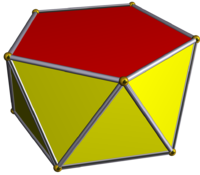thestruggle02
New member
- Joined
- Feb 25, 2021
- Messages
- 1
Hi guys, I need help with finding a suitable formula that involves the VERTICAL HEIGHT (I mean the height from the centre of the pentagonal base straight up until it reaches the centre of the top pentagonal roof, just to be clear) of the antiprism as well as the length of the SIDES that make up the pentagonal base.
Is there any formula for this shape that I'm describing? I need help urgently as my assignment is due very soon.

someone suggested using this formula, BUT replacing the a^3 by a^2*h, where h is the vertical height. Does that work??

My antiprism it irregular so the sides at the bottom that make up the pentagonal base are NOT equal to the sides of the triangle faces that go around the structure
Please I really need help!!
Is there any formula for this shape that I'm describing? I need help urgently as my assignment is due very soon.

someone suggested using this formula, BUT replacing the a^3 by a^2*h, where h is the vertical height. Does that work??

My antiprism it irregular so the sides at the bottom that make up the pentagonal base are NOT equal to the sides of the triangle faces that go around the structure
Please I really need help!!

